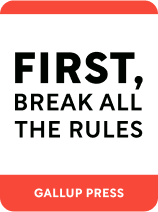

This article is an excerpt from the Shortform book guide to "First, Break All the Rules" by Gallup Press. Shortform has the world's best summaries and analyses of books you should be reading.
Like this article? Sign up for a free trial here .
Is Marcus Buckingham’s First Break All the Rules book worth reading? What are its key takeaways?
In his book First, Break All The Rules, Marcus Buckingham simply and clearly lays out proven management best practices. Then, he teaches how to hire the right people, create a productive working environment, and guide employees to success.
Here is a brief overview of First, Break All the Rules: What the World’s Greatest Managers Do Differently by Marcus Buckingham.
First, Break All the Rules: What the World’s Greatest Managers Do Differently
Below is a quick summary of the main takeaways from the First, Break All the Rules book by Michael Buckingham.
Measuring the Strength of Your Workplace
Most organizations know that their ability to find, engage, and maintain strong employees is essential to their success. However, few know how to gauge how well they’re doing at that task.
The Q12 Items
To determine how well you’re finding, engaging, and maintaining employees, you need a precise and thorough way to gauge the strength of your organization. The Q12 Items are 12 question items to give to your employees that help you determine the strength of your organization.
Employees respond to the Q12 on a scale of 1 (strongly disagree) to 5 (strongly agree). The items are as follows:
- I know what my company expects from me.
- I have the tools to effectively do my job.
- I have the opportunity to put my best talents to use every day.
- In the past week, I have been recognized for strong work.
- My manager, or someone else at work, cares about me as a human being.
- Someone at work promotes my development.
- My opinion matters.
- My company’s mission makes me feel like my job matters.
- My fellow employees commit to doing good work.
- I’ve made a best friend at work.
- Someone has talked to me about my development in the last six months.
- In the last year, I’ve had learning opportunities at work.
To improve your Q12 scores and become a stronger manager, develop the four keys of management:
- Hire Employees for Their Talents, Not For Their Skills or Knowledge
- Define Goals, Not Processes
- Build Up Talents and Navigate Around Weaknesses
- Guide Employees Towards the Right Fit
Key One: Hire Employees for Their Talents, Not For Their Skills or Knowledge
Talent is not a magical gift. Talent is a recurring feeling, thought, or behavior that can be used in an effective way. Every job lends itself to a unique set of talents and, therefore, requires a person with those talents to fill the role. For example, great lawyers have a talent for debating. Great accountants have a talent for organizing. Great caregivers have a talent for empathy.
Talent can’t be taught. Talents are developed at a young age and can’t be changed after your teenage years because of the way the brain works. Therefore, while you can give someone the tools to grow in their talents, you can’t teach talents like empathy or confidence. You need to hire people that already possess the necessary talents for the position.
How to Find Talent
How do you find talent to fit the positions that you need filled? When searching for new employees, clearly define the talents that describe the ideal worker for the position you’re trying to fill. Think about the following tips as you’re creating your list:
Tip #1: Think about the structure of your company. The talents associated with any given role will change based on the way your company is run. This is because your expectations and the way you interact with the person in that position are both unique to your organization.
Tip #2: Think about your current team members. Consider what talents you can add to your team to increase performance. Make sure that the people you hire have the appropriate talents to interact with your team effectively.
Tip #3: Look at your best employees. When coming up with your list of talents, think about the best employee you’ve ever had in that role or a closely related role. Then, consider the talents that they possess that allow them to succeed. Use these talents to inform your search.
Key Two: Define Goals, Not Processes
Contrary to popular belief, you don’t have direct control over your employees as a manager. While you can suggest specific ways to approach the work, your employees ultimately decide how they’re going to do their jobs based on their talents. However, despite the differing approaches, you need to ensure that everyone is performing to standard.
With this in mind, how do you get people to perform to expectation without having to micro-manage every aspect of their work? You need to define your team’s goals, then allow each employee to discover the best way to get there.
Don’t Micro-Manage
Many managers make the mistake of micro-managing their employees. They come up with a variety of excuses to justify their need to control every aspect of the work:
Excuse #1: I know the best way to approach the work. While it’s tempting to believe, there’s no one “best” approach to any position. Everyone has different talents that inform how they work effectively. While you can offer suggestions and resources to assist your employees, trying to dictate every step of their process ignores the talents that make them effective in the first place. Embrace the uniqueness of your employees and allow them to approach the work in a way that plays into their talents.
Excuse #2: My employees aren’t talented enough to work on their own. If you believe this, then you didn’t hire the right people for the job. In contrast, if you hire people based on their talents, then you should be able to step away with the knowledge that your employees are capable of doing the work.
Excuse #3: They need to earn my trust before I allow them to work on their own. If you think that you can’t trust your own team, you may be allowing your own insecurities to dictate the way that you run your team. Yes, sometimes, people will let you down. However, you need to embrace that this is the exception, not the rule.
How to Define Your Team’s Goals
Defining your team’s goals instead of their process helps you avoid micromanagement by giving your employees a unified objective to work towards without stifling their processes or talents. Every organization has different goals. For example, a retail store may focus primarily on customer satisfaction whereas a medical organization may focus primarily on patient safety. While these goals aren’t mutually exclusive, these organizations have different priorities because they have different purposes. When defining your organization’s goals, think about the following three questions:
Question #1: What do your customers need? This is the first question you need to ask because, without customers or clients, your company has no value. Use focus groups or customer surveys to ask your clientele what they want and expect from their experience with you. Use this information to inform your organization’s goals by zeroing in on the items that your customers feel passionate about.
Question #2: What does your company need? While a company’s core mission typically remains the same over time, the strategies you use to execute that mission change. Adapt your goals as you change your strategies. This adjusts the focus of your desired outcomes toward your new approach to fulfilling your company’s mission.
Question #3: What do your employees need? As you now know, every employee has a unique set of talents that inform the way that they work. When you set goals, you need to keep these talents in mind to adapt to each employee. While this is more challenging with larger or more standardized teams, you need to adjust as much as possible to ensure a more effective result.
Key Three: Build Up Talents and Navigate Around Weaknesses
Once you’ve hired for talent and defined your goals, build up the talents of your employees and figure out how to navigate around their weaknesses. As discussed, people don’t change that much. With this in mind, the talents and weaknesses of your employees are pretty much set. Instead of trying to fix your employees, help them build their talents by offering skills and knowledge, and navigate around their weaknesses by placing them into the appropriate positions.
Build Up Talents
You only have so much time and energy. Great managers believe that it’s better for employees to put their time and energy into building their talents instead of trying to change the unchangeable. Great managers use the following rules to help employees develop their abilities:
Rule #1: Put people in the proper roles. When placing people into roles, know the talents associated with each role as well as the talents of each individual employee. Watch your employees over time to see how they work and how they interact with other team members. If you like being more direct, ask them about their strengths, weaknesses, and goals. Note: this doesn’t refer simply to hiring. You can use this principle even if you have no power over hiring or need to shuffle an employee to a different position.
Rule #2: Break the Golden Rule. The “Golden Rule”—treating everyone the same—isn’t efficient. You need to relate to your employees based upon their individual needs. Here are examples of questions you can ask to get a better sense of what your employees need:
- What are your goals?
- How often do you want to talk about your progress?
- How do you like to be praised for good work?
- How do you like to learn?
Rule #3: Spend more time with your best. Keep the following tips in mind:
- Tip #1: Focus on your best because it’s the fair thing to do. While you should try to be fair, fairness isn’t giving everyone the same amount of attention. It’s giving attention proportionate to the amount of work a person puts in and the amount of success that they have. While this sounds blunt, it doesn’t make sense for you to invest your time into someone that doesn’t work hard or will never yield productive results.
- Tip #2: Make your good employees into great employees. Many managers obsess over average figures. Average figures show you the typical output of your organization and develop a level of “acceptable” performance. While it’s important to know the average efficiency of your office, it’s ineffective to use these figures as a barometer for success. You want your employees to be excellent, not average. Don’t spend time on employees who are below average or average. Instead, spend time on good employees who have the potential to be great, but know that it’s hard work to make even good employees truly great.
- Tip #3: When possible, avoid setting quotas and focus on praising excellence. When you focus on getting your team to reach a quota, your employees will coast once they’ve hit their goal. For example, a sales team that hits a quota of 100 sales per quarter will coast once they hit it. Instead, praise your top salespeople, use them as an example of excellence, then use their striving talents to continue to push them to excel.
Navigate Around Weakness
Focusing on talent doesn’t mean ignoring weakness or failure. Mistakes and poor performance need to be addressed quickly, but you need to address them properly to avoid frustrating employees or wasting your energy. First, ask yourself four questions:
- Is the poor performance due to personal issues?
- Is the poor performance due to a lack of proper tools or knowledge?
- Is the poor performance due to a lack of skills?
- Is the poor performance due to mishandled motivations?
If you answered “yes” to one of the questions above, you have direct control over the factors needed to make a change. This is because these questions relate to temporary (personal issues) or changeable (knowledge, skills, and motivations) factors. However, if you answered “no” to all of the questions above, you don’t have direct control over the factors needed to make a change. This is because your issue is likely related to talent. When this is the case, go through the following process:
Step One: Differentiate Between Non-Talents and Weaknesses
A non-talent is a talent you don’t have, but don’t have to use. On their own, non-talents are harmless. For example, if you’re terrible at remembering names, but your position never requires you to meet new people, your non-talent doesn’t impact your ability to work.
However, non-talents become weaknesses as soon as they become necessary to a role or position. For example, if you’re terrible at remembering names, and your new position frequently requires you to meet new people, your non-talent suddenly becomes a weakness. Knowing the difference between the two allows you to watch for the moments when your employee’s non-talents turn into weaknesses and impact performance.
Step Two: Use Three Methods to Help Struggling Employees
There are three methods you can use to help someone succeed despite their weaknesses:
- Method #1: Create a system of support. In regards to talent, support systems are tools and methods that help employees turn their weaknesses into non-talents. For example, if someone is bad at remembering when meetings are, have them put a calendar app on their computer that pings and shows a notification 15 minutes before their scheduled meetings. This changes their inability to remember scheduled meetings from a weakness to a non-talent.
- Method #2: Pair people together based on their talents and weaknesses. This will create a mutually beneficial relationship in which each employee can use their talents to cover the other person’s weaknesses. For instance, say you manage a team of sales reps. Rebecca always remembers names but struggles with her elevator pitch while Frank is terrible at remembering names but delivers a fantastic elevator pitch. With this in mind, you put Rebecca in charge of initiating conversations with potential clients and Frank in charge of then pitching the product.
- Method #3: Promote individual roles within teams. If you require someone to constantly rotate into a role or task that they’re not talented in, they won’t excel. Rather than requiring your employees to play all of the team’s roles, focus on the strengths and weaknesses of each employee and define their responsibilities accordingly. This allows each team member to use their talents while someone else covers their weaknesses. Once everyone is in a proper position and talents are balanced, you can build a level of proficiency throughout your team that allows them to cover different roles in the event of an emergency or unexpected development.
Step Three: If Nothing Works, Move or Remove Poor Performers
At the end of the day, if an employee is still performing poorly because of their weaknesses, they can’t stay in their position. Either find them an alternative role that better suits their talents or say goodbye.
Key Four: Guide Employees Towards the Right Fit
Employees want to develop in their careers. This has traditionally been associated with the concept of “climbing the ladder.” They feel the need to move up the chain of command in order to be seen as successful. However, employees who excel at one position often don’t have the talents to excel in a management or leadership role.
How do you keep people in roles they excel in and give them the feeling of accomplishment they need to feel fulfilled without promoting them into roles they don’t fit? You have to change people’s perspective on success, assure them that changing careers doesn’t make them a failure, and navigate people away from positions without destroying their morale.
Changing Perspectives on Success
While promotion is a great step when you have an employee who fits, it shouldn’t be your defining factor of success. Respect each position within your organization and develop ways that people can further their careers without changing roles. Three tips:
Tip #1: Develop achievement levels. Achievement levels are essentially promotions that allow team members to continue to do the work they excel in while gaining respect, prestige, and bonuses. These levels keep team members motivated by showing a clear progression of success without overhauling their job description. This allows them to become experts in their position while still feeling like they’re succeeding.
Tip #2: Adjust your payscale. To encourage great employees to stay in the roles they do well, create pay ranges that offer higher pay for great “lower-level” employees and lower pay for new or poor “higher level” employees. This works for two reasons:
- A broad range encourages employees to develop their skills. Promising financial incentives that align with expertise leads employees to focus on their skills to make more money rather than focusing on trying to get promoted.
- An overlapping range between the higher end of a “lower-level” position and a lower end of a “higher level” position forces employees to think before they take on a new role. This takes away the financial incentive for “promotion” and makes their desire to move a talent-based motivation instead of a fiscal one.
Tip #3: Get creative. Often, leadership won’t give you the freedom to develop achievement levels or adjust your pay scales. When leadership forces you to stick to a particular model, get creative and find ways to provide your employees with a sense of progression and development without breaking the rules. For example, if your boss insists that you must put someone into a management-level position, adjust the responsibility of the role into one of mentorship. This allows them to advance into the required role without forcing them into a position where they can’t use any of their talents.
Navigating Someone Out of a “Wrong” Fit
Moving an employee out of a role isn’t an easy thing to do. Unless they’ve committed a crime or unethical act, it’s emotionally difficult to demote, transfer, or fire people. However, because they drag down the group as a whole, you need to quickly remove poor performers from roles they aren’t talented in. This requires tough love:
- Tough: Determine your level of “unacceptable” performance and hold your team to that standard. If an employee consistently performs around or below average with no upward growth, they’re likely not going to achieve excellence in their position. While you should first offer them the tools and guidance to succeed, if nothing seems to work, the employee probably lacks the proper talents for the role.
- Love: Caring about your employees doesn’t mean lying to them. Your job as a manager is to set your employees up for success. When you remove someone from a role that they’re not well-suited for, you’re freeing them from the frustrations of putting energy into a position they won’t excel in. When you remove an employee, let them know that they do have talent. They just don’t have the right talents for this particular position.
In a lot of situations, you know your employees better than they know themselves. Though this may seem egotistical, it’s difficult to recognize your own talents and weaknesses when you’re the one doing the work. When you address an issue with an employee, they may grow defensive or angry because they don’t see their weaknesses. In these situations, stay calm and be consistent in your feedback.

———End of Preview———
Like what you just read? Read the rest of the world's best book summary and analysis of Gallup Press's "First, Break All the Rules" at Shortform .
Here's what you'll find in our full First, Break All the Rules summary :
- Why only 13% of the world’s workforce is actively engaged at work
- How to find strong employees and keep them
- The 12 questions to ask your employees that help you determine the strength of your organization







I connected with what I recently read about “First, Break All the Rules” on shortform.com. It brought to mind an instance when I had to defy expectations in order to make progress at work. I discovered that, as the book implies, there are instances when defying the norm may result in success and creativity. Books like “Extreme Ownership” and “The Dichotomy of Leadership” from https://echelonfront.com/books/ could prove helpful if you’re interested in learning more about nontraditional leadership techniques. They provide useful advice on how to think creatively and promote change.